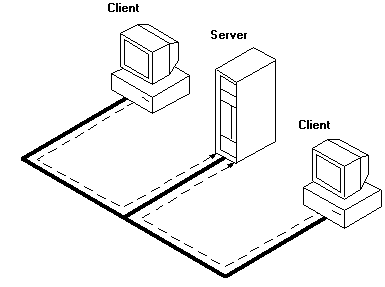
Client-server architecture is an effective and popular design for distributed applications. In the client-server model, an application is split into two parts: a front-end client that presents information to the user, and a back-end server that stores, retrieves, and manipulates data, and generally handles the bulk of the computing tasks for the client. In this model, the server is usually a more powerful computer than the client and serves as a central data store for many client computers, thus making the system easy to administer.
Typical examples of client-server applications include shared databases, remote file servers, and remote printer servers. The following figure illustrates the client-server model.

Network systems support the development of client-server applications through an interprocess communication (IPC) facility in which the client and server can communicate and coordinate their work. You can use NetBIOS NCBs (network control blocks), mailslots, or named pipes to transfer information between two or more computers.
For example, the client can use an IPC mechanism to send an opcode and data to the server requesting that a particular procedure be called. The server receives and decodes the request and calls the appropriate procedure. The server then performs all the computations needed to satisfy the request and returns the result to the client. Client-server applications are usually designed to minimize the amount of data transmitted over the network.
Using NetBIOS, mailslots, or named pipes to implement interprocess communication means learning specific details relating to network communication. Each application must manage the network-specific conditions. To write this network-specific level of code, you must:
In addition to all the possible errors that can occur on a single computer, the network has its own error conditions. For example, a connection can be lost, a server can disappear from the network, the network security service can deny access to system resources, or users can compete for and tie up system resources. Because the state of the network is always changing, an application can fail in new and interesting ways that are difficult to reproduce. For these reasons, each application must rigorously handle all possible error conditions.
When you write a client-server application, you must provide the layer of code that manages network communication. The advantage of using Microsoft RPC is that the RPC tools provide this layer for you. RPC virtually eliminates the need to write network-specific code, thus making it easier to develop distributed applications.
Using the remote procedure call model, RPC tools manage many of the details relating to network protocols and communication. This allows you to focus on the details of the application rather than the details of the network.